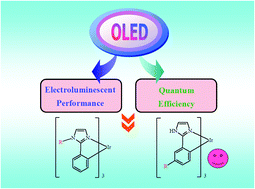Computational insights into the photophysical and electroluminescence properties of homoleptic fac-Ir(C^N)3 complexes employing different phenyl-derivative-featuring phenylimidazole-based ligands for promising phosphors in OLEDs†
Abstract
The electronic structures and photophysical properties of three homoleptic iridium(III) complexes IrL3 with C^N ligands, including 2a (L = 1-(2,6-diisopropylphenyl)-2-phenyl-1H-imidazole), 5a (L = 1-(2,6-dimethylphenyl)-2-phenyl-1H-imidazole), and 6a (L = 1-(3,5-diisopropylbiphenyl-4-yl)-2-phenyl-1H-imidazole), are investigated by means of the density functional method. Furthermore, seven new complexes are theoretically designed, including 1a (L = 1,2-diphenyl-1H-imidazole), 3a (L = 1-(2,6-dimethoxyphenyl)-2-phenyl-1H-imidazol), 4a (L = 2-(2-phenyl-1H-imidazol-1-yl)isophthalaldehyde), 1b (L = 2-(biphenyl-3-yl)-1H-imidazole), 2b (L = 2-(2′,6′-diisopropylbiphenyl-3-yl)-1H-imidazole), 3b (L = 2-(2′,6′-dimethoxybiphenyl-3-yl)-1H-imidazole), and 4b (L = 3′-(1H-imidazol-2-yl)biphenyl-2,6-dicarbaldehyde), to explore the influence of different substituents and different substituted positions on the electronic structures, phosphorescence properties, and organic light-emitting diode (OLED) performance. The HOMO–LUMO energy gap is greatly decreased by introduction of the –CHO group into the phenyl ring (4a and 4b see


 Please wait while we load your content...
Please wait while we load your content...